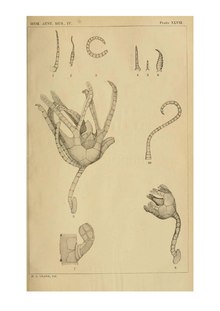
Crinoids are marine animals that make up the class Crinoidea. Crinoids that are attached to the sea bottom by a stalk in their juvenile form are commonly called sea lilies, while the unstalked forms, called feather stars or comatulids, are members of the largest crinoid order, Comatulida. Crinoids are echinoderms in the phylum Echinodermata, which also includes the starfish, brittle stars, sea urchins and sea cucumbers. They live in both shallow water and in depths as great as 9,000 meters (30,000 ft).
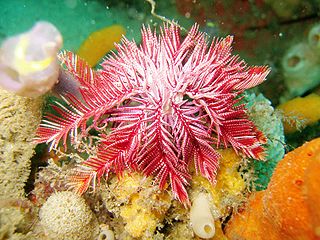
Articulata are a subclass or superorder within the class Crinoidea, including all living crinoid species. They are commonly known as sea lilies or feather stars. The Articulata are differentiated from the extinct subclasses by their lack of an anal plate in the adult stage and the presence of an entoneural system. Articulata first appeared in the fossil record during the Triassic period although other, now extinct crinoid groups, originated in the Ordovician.

Comasteridae is a family of crinoids.
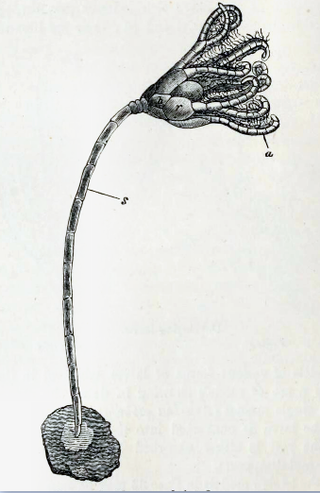
Antedon bifida is a species of crinoid in the family Antedonidae commonly known as the rosy feather star. It is found in north west Europe.

Antedon petasus is a marine invertebrate, a species of crinoid or feather star in the family Antedonidae. It is found around the coasts of north west Europe.

Comatulida is an order of crinoids. Members of this order are known as feather stars and mostly do not have a stalk as adults. The oral surface with the mouth is facing upwards and is surrounded by five, often divided rays with feathery pinnules. Comatulids live on the seabed and on reefs in tropical and temperate waters.
Davidaster discoideus, the beaded crinoid, is a species of feather star in the family Comatulidae. It was previously known as Nemaster discoidea but the World Register of Marine Species has determined that the valid name is Davidaster discoideus. It is found on reefs in the Caribbean Sea and northern coast of South America.
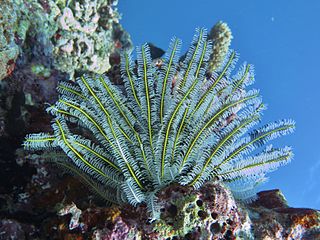
Comaster schlegelii, the variable bushy feather star, is a crinoid in the family Comatulidae. It was previously classified as Comanthina schlegeli but further research showed that it was better placed in the genus Comaster. It is found on shallow water reefs in the western Pacific Ocean.
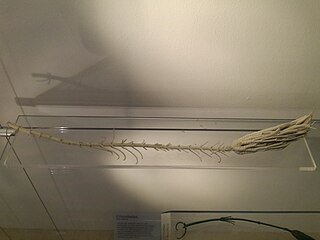
Metacrinus rotundus, the Japanese sea lily, is a marine invertebrate, a species of stalked crinoid in the family Isselicrinidae. It is a species found off the west coast of Japan, and is living near the edge of the continental shelf, around 100–150m deep. This is the shallowest species among the extant stalked crinoids.

Oxycomanthus bennetti, the Bennett's feather star, is a species of crinoid belonging to the family Comatulidae. It is found in shallow water in the Indo-Pacific between northern Australia and southeast Asia.

Antedon mediterranea is a species of stalkless crinoid in the family Antedonidae, commonly known as the Mediterranean feather star. It is found on the seabed at moderate depths in the Mediterranean Sea. It is a filter feeder and captures plankton with its long feathery arms.

Cenocrinus is a monotypic genus of stalked crinoids in the family Isselicrinidae. The great West Indian sea lily is the only species in the genus and is found in deep waters in the Caribbean Sea and Gulf of Mexico.

Ptilometra australis, the passion flower feather star, is a species of crinoid. It is native to the coasts of southeastern Australia where it is found on reefs, in estuaries and bays at depths down to about 110 metres (360 ft).

Leptometra celtica is a marine invertebrate and species of crinoid or feather star of the Leptometra genus in the family Antedonidae. It is found in the Atlantic Ocean around the coasts of north west Europe. The presence of L. celtica and L. phalangium is considered to be a good indication of nearby shelf breaks, general bottom currents, and areas of high gross productivity as they are suspension-feeders, hence their proliferation in productive environments.

Florometra serratissima is a species of crinoid or feather star in the family Antedonidae. It is found off the Pacific coast of North America, usually in deep water.
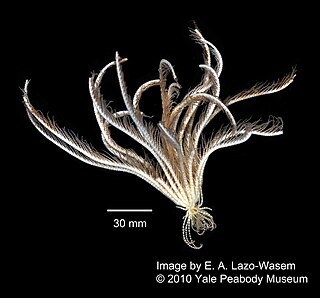
Promachocrinus kerguelensis is a species of free-swimming, stemless crinoids. It was the only member of its genus until several species were discovered in 2023. P. keruguelensis a coldwater crinoid which is found in the seas around Antarctica and surrounding island groups, including under the sea ice.

Aporometra wilsoni is a marine invertebrate, a species of crinoid or feather star in the family Aporometridae. It is found in shallow water around the coasts of southern Australia.

Aporometridae is a monotypic family of crinoids, the only genus being Aporometra, which contains three species, all endemic to the seas around Australia.

Notocrinus virilis is a marine invertebrate, a species of crinoid or feather star in the family Notocrinidae. It is found in deep water in the Southern Ocean around the coasts of Antarctica and adjacent islands. A sea snail sometimes parasitizes it.
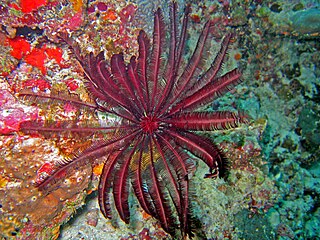
Cenometra bella is a species of crinoids belonging to the genus Cenometra. They can have up to 30 arms and can be of variable colours but are often characterised by a marked contrast between the extending free-arms and the feathery pinnules. This species clings to its support and moves around by its feet-like cirri.

